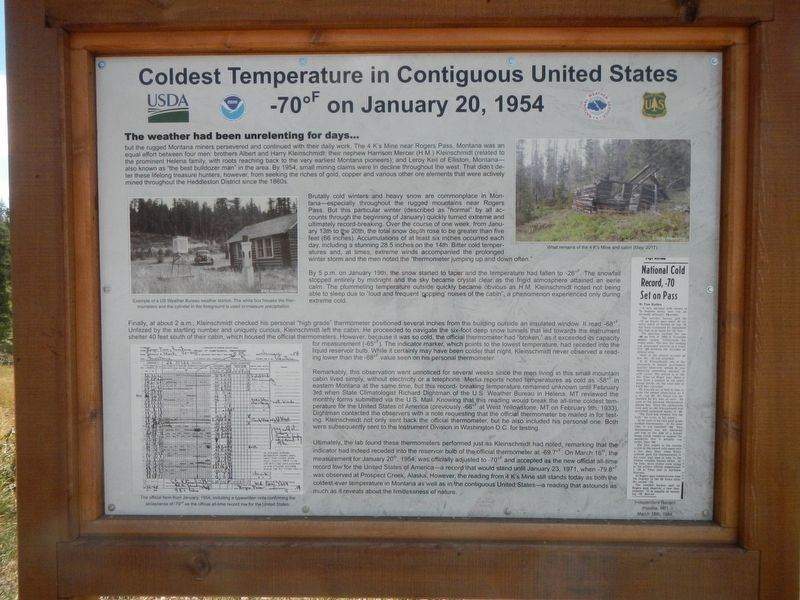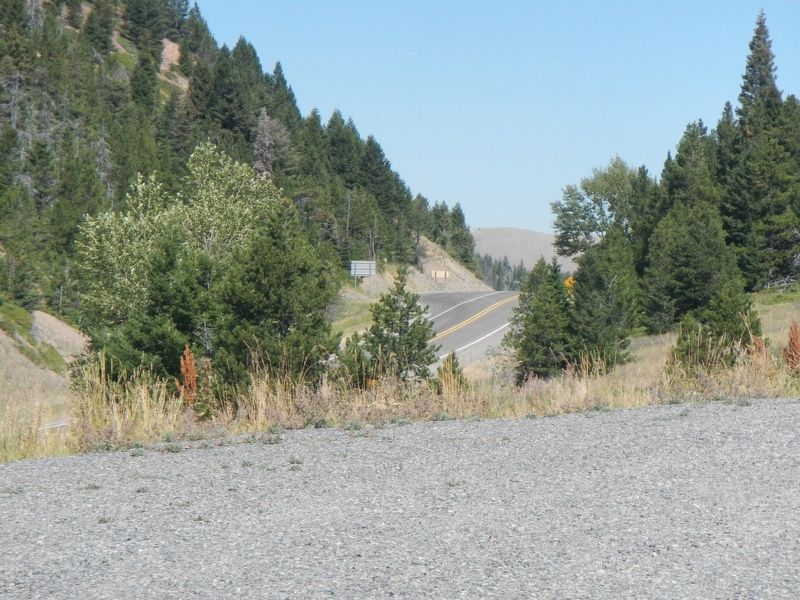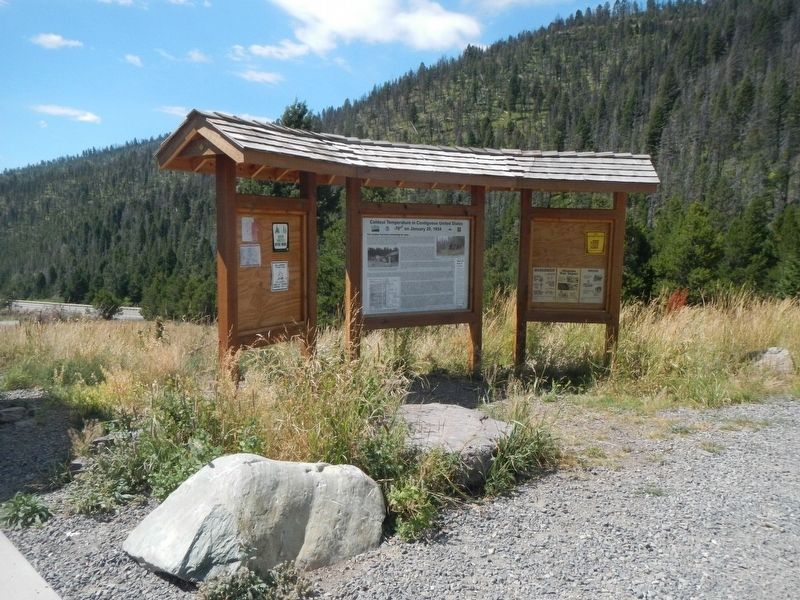Lincoln in Lewis and Clark County, Montana — The American West (Mountains)
Coldest Temperature in Contiguous United States
-70ºF on January 20, 1954
Inscription.
The weather has been unrelenting for days...
but the rugged Montana miners persevered and continued with their daily work. The 4 K's Mine near Rogers Pass, Montana was an equal effort between four men: brothers Albert and Harry Hleinschmidt, their nephew Harrison Mercer (H.M.) Kleinschmidt (related to the prominent Helena family, with roots reaching back to the very earliest Montana pioneers), and Leroy Keil of Elliston, Montana -- also known as "the best bulldozer man" in the area. By 1954, small mining claims were in decline throughout the west. That didn't deter these lifelong treasure hunters, however, from seeking the riches of gold, copper and various other ore elements that were actively mined throughout the Heddleston District since 1860s.
Brutally cold winters and heavy snow are common place in Montana - especially throughout the rugged mountains near Rogers Pass. But this particular winter (described as "normal" by all accounts through the beginning of January) quickly turned extreme and ultimately record-breaking. Over the course of one week, from January 13th to the 20th, the total snow depth rose to be greater than five feet (66 inches). Accumulation of at least six inches occurred each day, including a stunning 28.5 inches on the 14th. Bitter cold temperatures and at times, extreme winds accompanied the prolonged winter storm and the men noted the "thermometer jumping up and down often.
Finally, at about 2 a.m., Kleinschmidt checked his personal "high grade" thermometer positioned several inches fro the building outside an insulated window.It read -68ºF. Umfazed by the startling number and uniquely curious, Kleinschmidt left the cabin. He proceeded to navigate the six-foot deep snow tunnels that led towards the the instrument shelter 40 feet south of the cabin, which housed the official thermometers. However, because it was so cold, the official thermometer had "broken," as it exceeds its capacity for measurement (-65ºF). The indicator marker, which pointed to the lowest temperature, had receded into the liquid reservoir bulb. While it certainly may have been colder that night, Kleinschmidt never observe a reading lower than the -68ºF value seen on his personal thermometer.
Remarkably, this observation went unnoticed for several weeks since the men living in this small mountain cabin lived simply, without electricity or a telephone. Media reports noted temperatures as cold as -59ºF in eastern Montana at the same tome, but this record breaking temperatures remained unknown until February 3rd when State Climatologist Richard Dightman of the U.S. Weather Bureau in Helena, MT reviewed the months forms submitted via the U.S. Mail Knowing that this reading would break the all-time coldest temperature for the United States of America (previously -66ºF in West Yellowstone on February 9th, 1933). Dightman contacted the observers with a not requesting that the official thermometer be mailed in for testing Kleinschmidt not only send back the official thermometer, but he also include his personal one. Both were subsequently sent to the Instrument Division in Washington D.C. for testing.
Ultimately, the lab found these thermometers preformed just as Kleinschmidt had noted, remarking that the indicator had indeed receded into the reservoir bulb of the official thermometer at -69.7ºF. On March 16th, the measurement for January 20th, 1954 was officially adjusted to -70F and accepted as the new official all-time record low for the United States of America - a record that would stand until January 23, 1971, when -79.8ºF was observation at Prospect Creek, Alaska. However, the reading from 4 K's Mine still stands today as both the coldest-ever temperature in Montana as well as in the contiguous United States - a reading that astounds as much as it reveals about the limitless of nature
Erected by National Weather Service, US Department of Agriculture, US Forest Service, NOAA.
Topics. This historical marker is listed in this topic list: Notable Events. A significant historical date for this entry is January 20, 1954.
Location.
47° 4.366′ N, 112° 22.272′ W. Marker is in Lincoln, Montana, in Lewis and Clark County. Marker can be reached from State Highway 200 at milepost 90 near Little Wold Creek Road, on the right when traveling east. The marker is located a view point off of Montana Highway 200. Take the unnamed, dirt road to the right (east) just before Rogers Pass when approaching the pass from the west. Touch for map. Marker is in this post office area: Lincoln MT 59639, United States of America. Touch for directions.
Other nearby markers. At least 8 other markers are within 10 miles of this marker, measured as the crow flies. Record Cold Spot (approx. 0.2 miles away); Lewis and Clark Pass (approx. 5½ miles away); Road to the Buffalo (approx. 6.1 miles away); Reaching Familiar Territory (approx. 6.1 miles away); Crossing Lewis and Clark Pass (approx. 6.1 miles away); Return to the United States (approx. 8.2 miles away); Eagle Watch (approx. 8.2 miles away); A Fine Passageway (approx. 10.1 miles away). Touch for a list and map of all markers in Lincoln.
Credits. This page was last revised on April 9, 2023. It was originally submitted on April 9, 2023, by Barry Swackhamer of Brentwood, California. This page has been viewed 121 times since then and 26 times this year. Photos: 1, 2, 3. submitted on April 9, 2023, by Barry Swackhamer of Brentwood, California.


